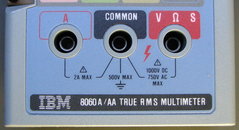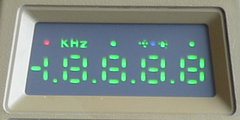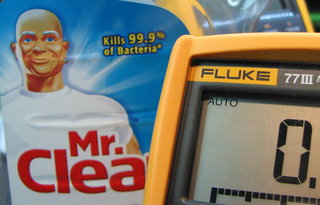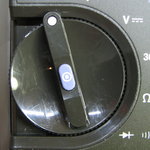 Not much time for blogging these days, but this one is overdue. A reader of this blog was kind enough to send me his retired IBM 8060A/AA multimeter. (Thank you HK.) This is really a Fluke 8060A in a light blue/gray case, with IBM branding. Presumably IBM bought a lot of these for their engineers, field technicians, and laboratories. It even came with its own special blue service manual, which another friend gifted me with a copy, so that I have a matching set for Mr. Modemhead’s Multimeter Museum.
Not much time for blogging these days, but this one is overdue. A reader of this blog was kind enough to send me his retired IBM 8060A/AA multimeter. (Thank you HK.) This is really a Fluke 8060A in a light blue/gray case, with IBM branding. Presumably IBM bought a lot of these for their engineers, field technicians, and laboratories. It even came with its own special blue service manual, which another friend gifted me with a copy, so that I have a matching set for Mr. Modemhead’s Multimeter Museum.
-
Recent Posts
Chatter
- Dave Wise on Keithley 135 DMM
- Nico Groß on Fluke 83 DMM Repair
- Nico Groß on Fluke 83 DMM Repair
- Dave Wise on Fluke 87 Fusible Resistor
- Andy Preston on Beckman Industrial HD110 Multimeter
- Kenn on HP 3468A Bench Multimeter Repair
- Kenn on HP 3468A Bench Multimeter Repair
- Lope A. Marcos on Fluke 80-series Jack Assembly Rebuild
Tags
Categories
Archives
Forums
Helpful Vendors
More To Explore
YouTube Channels

 Blog reader “
Blog reader “ There seems to be a trend in Fluke repairs here lately. Other than your occasional fusible resistor, the problems seem to be related to materials instead of electronic bits.
There seems to be a trend in Fluke repairs here lately. Other than your occasional fusible resistor, the problems seem to be related to materials instead of electronic bits.  Recently
Recently  Happy New Year 2014! Doing some housekeeping and software updates, found this information was buried in the photo galleries.
Happy New Year 2014! Doing some housekeeping and software updates, found this information was buried in the photo galleries.